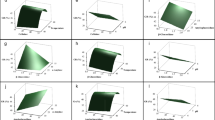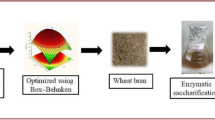Abstract
This work describes a microreaction technique to carry out hydrolysis of certain substrate by certain enzyme under several conditions, and reports its usefulness to determine effective process conditions and to compare performances between different systems substrate-enzyme, in a quick and economic way. The microreaction system consists of microtubes, as microreactors, that are placed into a thermomixer, allowing a set of 24 experiments at a certain constant temperature but with different pH and substrate-enzyme ratios. The outcomes of the numerous experiments are processed via response surface methodology and means analysis. In order to illustrate the technique effectiveness, it is discussed the comparison of two commercial enzyme complexes, and two delignification procedures of wheat straw.



Similar content being viewed by others
References
Parajuli R, Dalgaard T, Jørgensen U, Adamsen APS, Knudsen MT, Birkved M, Gylling M, Schjørring JK (2015) Biorefining in the prevailing energy and materials crisis: a review of sustainable pathways for biorefinery value chains and sustainability assessment methodologies. Renew Sust Energ Rev 43:244–263. https://doi.org/10.1016/j.rser.2014.11.041
Gaurav N, Sivasankari S, Kiran GS, Ninawe A, Selvin J (2017) Utilization of bioresources for sustainable biofuels: a review. Renew Sust Energ Rev 73:205–2014. https://doi.org/10.1016/j.rser.2017.01.070
Gottumukkala LD, Haigh K, Görgens J (2017) Trends and advances in conversion of lignocellulosic biomass to biobutanol: microbes, bioprocesses and industrial viability. Renew Sust Energ Rev 76:963–973. https://doi.org/10.1016/j.rser.2017.03.030
Taghizadeh-Alisaraei A, Hosseini SH, Ghobadian B, Motevali A (2017) Biofuel production from citrus wastes: a feasibility study in Iran. Renew Sust Energ Rev 69:1100–1112. https://doi.org/10.1016/j.rser.2016.09.102
Rao LV, Goli JK, Gentela J, Koti S (2016) Bioconversion of lignocellulosic biomass to xylitol: an overview. Bioresour Technol 213:299–310. https://doi.org/10.1016/j.biortech.2016.04.092
Yang M, Kuittinen S, Vepsäläinen J, Zhang J, Pappinen A (2017) Enhanced acetone-butanol-ethanol production from lignocellulosic hydrolysates by using starchy slurry as supplement. Bioresour Technol 243:126–143. https://doi.org/10.1016/j.biortech.2017.06.021
Aditiya HB, Mahlia TMI, Chong WT, Nur H, Sebayang AH (2016) Second generation bioethanol production: a critical review. Renew Sust Energ Rev 66:631–653. https://doi.org/10.1016/j.rser.2016.07.015
Mood SH, Golfeshan AH, Tabatabaei M, Jouzani GS, Najafi GH, Gholami M, Ardjmand M (2013) Lignocellulosic biomass to bioethanol, a comprehensive review with a focus on pretreatment. Renew Sust Energ Rev 27:77–93. https://doi.org/10.1016/j.rser.2013.06.033
Zabed H, Sahu JN, Suely A, Boyce AN, Faruq G (2017) Bioethanol production from renewable sources: current perspectives and technological progress. Renew Sust Energ Rev 71:475–501. https://doi.org/10.1016/j.rser.2016.12.076
Ballesteros M (2010) Enzymatic hydrolysis of lignocellulosic biomass. In: Waldron K (ed) Bioalcohol production: biochemical conversion of lignocellulosic biomass. Woodhead Publishing Limited, Cambridge, pp 159–177. https://doi.org/10.1533/9781845699611.2.159
Marcos M, García-Cubero MT, González-Benito G, Coca M, Bolado S, Lucas S (2012) Optimization of the enzymatic hydrolysis conditions of steam-exploded wheat straw for maximum glucose and xylose recovery. J Chem Technol Biotechnol 88(2):237–246. https://doi.org/10.1002/jctb.3820
Eliana C, Jorge R, Juan P, Luis R (2014) Effects of the pretreatment method on enzymatic hydrolysis and ethanol fermentability of the cellulosic fraction from elephant grass. Fuel 118:41–47. https://doi.org/10.1016/j.fuel.2013.10.055
Adney B, Baker J (1996) Measurement of cellulase activities, Laboratory Analytical Procedure, National Renewable Energy Laboratory, Technical Report NREL/TP 510-42628
Martins LF, Kolling D, Camassola M, Dillon AJP, Ramos LP (2008) Comparison of Penicillium echinulatum and Trichoderma reesei cellulases in relation to their activity against various cellulosic substrates. Bioresour Technol 99(5):1417–1424. https://doi.org/10.1016/j.biortech.2007.01.060
Hamzah F, Idris A, Shuan TK (2011) Preliminary study on enzymatic hydrolysis of treated oil palm (Elaeis) empty fruit bunches fibre (EFB) by using combination of cellulase and β 1-4 glucosidase. Biomass Bioenergy 35(3):1055–1059. https://doi.org/10.1016/j.biombioe.2010.11.020
Brummer V, Jurena T, Hlavacek V, Omelkova J, Bebar L, Gabriel P, Stehlik P (2014) Enzymatic hydrolysis of pretreated waste paper - source of raw material for production of liquid biofuels. Bioresour Technol 152:543–547. https://doi.org/10.1016/j.biortech.2013.11.030
Riedlberger P, Weuster-Botz D (2012) New miniature stirred-tank bioreactors for parallel study of enzymatic biomass hydrolysis. Bioresour Technol 106:138–146. https://doi.org/10.1016/j.biortech.2011.12.019
Palmqvist B, Wiman M, Lidén G (2011) Effect of mixing on enzymatic hydrolysis of steam-pretreated spruce: a quantitative analysis of conversion and power consumption. Biotechnol Biofuels 4(1):10. https://doi.org/10.1186/1754-6834-4-10
Świątek K, Lewandowska M, Świątek M, Bednarski W, Brzozowski B (2014) The improvement of enzymatic hydrolysis efficiency of rape straw and Miscanthus giganteus polysaccharides. Bioresour Technol 151:323–331. https://doi.org/10.1016/j.biortech.2013.10.090
Ertas M, Han Q, Jameel H, Chang HM (2014) Enzymatic hydrolysis of autohydrolyzed wheat straw followed by refining to produce fermentable sugars. Bioresour Technol 152:259–266. https://doi.org/10.1016/j.biortech.2013.11.026
Longwell CK, Labanieh L, Cochran JR (2017) High-throughput screening technologies for enzyme engineering. Curr Opin Biotechnol 48:196–202. https://doi.org/10.1016/j.copbio.2017.05.012
Yu X, Liu Y, Cui Y, Cheng Q, Zhang Z, Lu JH, Meng Q, Teng L, Ren X (2016) Measurement of filter paper activities of cellulase with microplate-based assay. Saudi J Biol Sci 23(1):S93–S98. https://doi.org/10.1016/j.sjbs.2015.06.018
Jäger G, Wulfhorst H, Zeithammel EU, Elinidou E, Spiess AC, Büchs J (2011) Screening of cellulases for biofuel production: online monitoring of the enzymatic hydrolysis of insoluble cellulose using high-throughput scattered light detection. Biotechnol J 6(1):74–85. https://doi.org/10.1002/biot.201000387
Van Dyk JS, Pletschke BI (2012) A review of lignocellulose bioconversion using enzymatic hydrolysis and synergistic cooperation between enzymes—factors affecting enzymes, conversion and synergy. Biotechnol Adv 30(6):1458–1480. https://doi.org/10.1016/j.biotechadv.2012.03.002
Saha BC, Iten LB, Cotta MA, Wu YV (2005) Dilute acid pretreatment, enzymatic saccharification and fermentation of wheat straw to ethanol. Process Biochem 40(12):3693–3700. https://doi.org/10.1016/j.procbio.2005.04.006
AOAC International (2005) Official methods of analysis, 18th edition, Method 973.18 Fiber (Acid Detergent) and Lignin in Animal Feed, Maryland USA
Doner LW, Hicks KB (1997) Isolation of hemicellulose from corn fiber by alkaline hydrogen peroxide extraction. Cereal Chem 74(2):176–181. https://doi.org/10.1094/CCHEM.1997.74.2.176
Sun R, Tomkinson J, Fang J (2000) Isolation and characterization of hemicelluloses and cellulose from rye straw by alkaline peroxide extraction. Cellulose 7(1):87–107. https://doi.org/10.1023/A:1009245100275
Sun R, Tomkinson J, Wang S, Zhu W (2000) Characterization of lignins from wheat straw by alkaline peroxide treatment. Polym Degrad Stab 67(1):101–109. https://doi.org/10.1016/S0141-3910(99)00099-3
Dowe NS, Lussier JM, Gleason RM (2008) Novel method for the rapid simultaneous measurement of xylose and glucose for bioethanol production. www.ysi.com. Accessed 23 Aug 2017
Miller GL (1959) Use of dinitrosalicylic acid reagent for determination of reducing sugar. Anal Chem 31(3):426–428. https://doi.org/10.1021/ac60147a030
Montgomery DC (2013) Design and analysis of experiments. New Jersey
Coimbra MC, Duque A, Saéz F, Manzanares P, Garcia-Cruz CH, Ballesteros M (2016) Sugar production from wheat straw biomass by alkaline extrusion and enzymatic hydrolysis. Renew Energ 86:1060–1068. https://doi.org/10.1016/j.renene.2015.09.026
Cabrera E, Muñoz MJ, Martín R, Caro I, Curbelo C, Díaz AB (2014) Alkaline and alkaline peroxide pretreatments at mild temperature to enhance enzymatic hydrolysis of rice hulls and straw. Bioresour Technol 167:1–7. https://doi.org/10.1016/j.biortech.2014.05.103
Rojas-Rejón OA, Sánchez A (2014) The impact of particle size and initial solid loading on thermochemical pretreatment of wheat straw for improving sugar recovery. Bioprocess Biosyst Eng 37(7):1427–1436. https://doi.org/10.1007/s00449-013-1115-z
Eveleigh DE, Mandels M, Andreotti R, Roche C (2009) Measurement of saccharifying cellulase. Biotechnol Biofuels 2(1):21. https://doi.org/10.1186/1754-6834-2-21
Grosch JH, Sieben M, Lattermann C, Kauffmann K, Büchs J, Spieß AC (2016) Enzyme activity deviates due to spatial and temporal temperature profiles in commercial microtiter plate readers. Biotechnol J 11(4):519–529. https://doi.org/10.1002/biot.201500422
Funding
Financial support from Secretary of Energy (SENER), México (Project SENER 2009-150001) is acknowledged.
Author information
Authors and Affiliations
Corresponding author
Rights and permissions
About this article
Cite this article
Hernández-Beltrán, J.U., Cervantes-Quintero, K. & Hernández-Escoto, H. A quick and effective method for evaluating substrate-enzyme systems in the enzymatic hydrolysis of lignocellulosic biomass. Biomass Conv. Bioref. 8, 437–446 (2018). https://doi.org/10.1007/s13399-017-0297-z
Received:
Revised:
Accepted:
Published:
Issue Date:
DOI: https://doi.org/10.1007/s13399-017-0297-z




